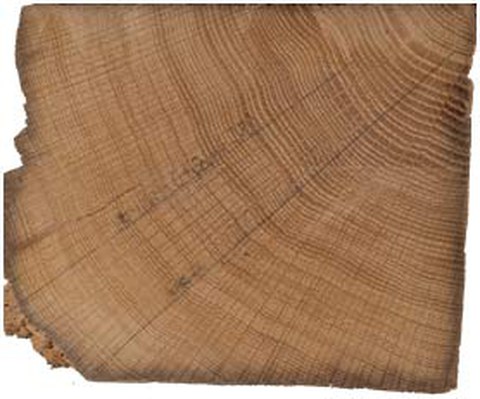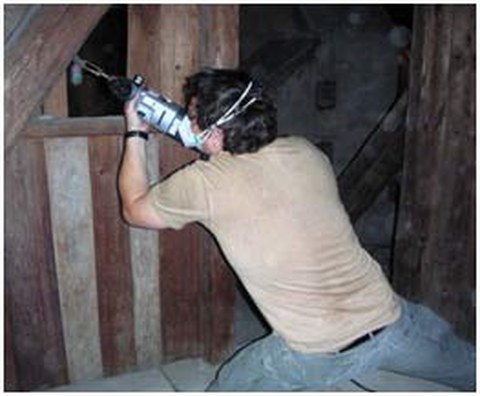Dendrochronologie
Dendrochronologie als Dienstleistung
Die Dendrochronologie ist ein naturwissenschaftliches Verfahren zur jahrgenauen Altersbestimmung von hölzernen Proben auf der Grundlage eines Vergleiches der Jahrringbreitenmessreihe einer Probe mit einer Jahrringbreitenchronologie.

Bild 1: Eichenscheibe mit 106 Jahrringen aus der Ev.-Luth. Kirche in Kreischa - der äußere Jahrring wurde auf das Jahr 1724 datiert.
Die Methode der Dendrochronologie geht auf Douglass (Arizona, 1908) zurück. Die Pflege des dendrochronologischen Erbes von Prof. Huber, dem Begründer der Dendrochronologie in Europa, ist ein wichtiges Anliegen des Professur für Forstnutzung und des Dendro-Institutes (mit Prof. Bues, Prof. Roloff, Prof. Röhle u. a.) in Tharandt. Mitarbeiter der Professur für Forstnutzung und des Dendro-Instituts Tharandt führen wissenschaftlich fundierte Forschung durch und erbringt Leistungen auf dem Gebiet der Dendrochronologie für die angewandte Bau- und Geschichtsforschung in Mitteldeutschland.
Bauwesen und Denkmalpflege

Bild 2: Entnahme von Bohrkernen im Dachstuhl des Jagdschlosses in Graupa
In Zusammenarbeit mit anerkannten Zentren der Jahrringforschung werden in Tharandt auf dem Fachgebiet der Dendrochronologie Forschungsthemen bearbeitet und Service-Leistungen insbesondere in Brandenburg, Sachsen, Sachsen-Anhalt und Thüringen erbracht.
So wurden in den zurückliegenden Jahren sowohl Auftragsarbeiten aus dem Bereich der klein- und mittelständischen Unternehmen durchgeführt, als auch Aufträge zur Datierung von Dachkonstruktionen in der Albrechtsburg Meißen oder der Denkmalpflege der mitteldeutschen Region durchgeführt.
Die Probenentnahme kann durch Mitarbeiter der Professur bzw. des Dendro-Institutes erfolgen.
Führt der Auftraggeber die Auswahl, Entnahme und Dokumentation der Proben selbst durch, sollten folgende Richtlinien zur Probenbeschaffenheit und Probenanzahl beachtet werden:
- Grundlage der Datierung ist eine messbare Jahrringfolge. Jede zu datierende Probe soll mindestens 50 Jahrringe umfassen. Holzstücke mit kürzeren Ringfolgen bergen das Risiko, nicht datierbar zu sein und können ggf. nur in Verbindung mit gesicherten Mittelkurven (ausreichende Stichprobenanzahl) datiert werden. Proben mit weniger als 25 Jahrringen sind nicht sicher datierbar. Bearbeitet werden folgende Baumarten: Eiche, Kiefer, Tanne, Fichte, Esche, Buche, u. U. auch Erle und Ulme.
- Zur Bearbeitung einer Fragestellung gehören i. d. R. etwa 5 verschiedene Einzelproben. Mehrere Proben ermöglichen meist eine gesicherte Datierung. Normalerweise werden etwa 2-8 cm dicke Scheiben (senkrecht zur Wuchsrichtung ausgesägte Querschnitte aus Stammholz oder Balken) bearbeitet. Die Proben sollten möglichst regelmäßig und astfrei gewachsen sein. Wichtig für die Ermittlung des Fällungsjahres ist das Vorhandensein der Waldkante (der letzte gewachsene Jahrring des Baumes vor der Fällung).
- Aus verbauten Holzelementen werden nach Absprache Bohrkerne (Durchmesser: 16 - 25 mm) entnommen. Bei Bedarf und gut erhaltenem Holz kann auch mit einem Zuwachsbohrer (10 mm) gebohrt werden. Bei Objekten, die nicht beschädigt werden dürfen, besteht die Möglichkeit, die Vermessung der Jahrringbreiten anhand von Fotos der Holzquerschnitte durchzuführen.
Wissenschaftlicher Mitarbeiter
NameDr. rer. silv. Björn Günther
Eine verschlüsselte E-Mail über das SecureMail-Portal versenden (nur für TUD-externe Personen).
